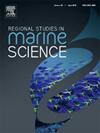Determining horizontal and vertical distributions of polar cod (Boreogadus saida) in the Bering Sea and western Arctic Ocean using traditional sampling and environmental DNA metabarcoding
IF 2.4
4区 环境科学与生态学
Q3 ECOLOGY
引用次数: 0
Abstract
Boreogadus saida, commonly known as polar cod, is a key species in Arctic marine ecosystems that is also an indicator of environmental change. This study examined the spatial distribution of B. saida, which typically inhabits circumpolar waters ranging in temperature from −2 to 8°C. Age classification based on size was performed on fish samples collected using ring nets, frame trawl nets, and hand nets. The results demonstrated that most individuals collected by ring and frame trawl nets in the southern Chukchi Sea (SCS) and East Siberian Sea (ESS) during late July and early August were age-0, while those collected in mid-August were age-1 and age-2. The individuals collected by hand net in the surface of the ESS and the northern Chukchi Sea (NCS) were all in age-1 and age-2 + . Smaller larvae collected in the ESS suggested local spawning grounds. Environmental factors, particularly temperature and prey availability, were found to influence habitat selection. To complement traditional sampling methods, environmental DNA (eDNA) metabarcoding using MiFish primers was conducted at various horizontal and vertical sites across the Bering Sea (BS), Chukchi Sea (CS), and ESS. B. saida eDNA was detected from surface waters to a maximum depth of 1804 m at temperatures ranging from −1.6 to 4.4°C, which demonstrated the utility of eDNA for mapping both horizontal and vertical distributions. These findings highlight the value of integrating eDNA metabarcoding with conventional techniques to clarify B. saida’s distribution and life history. They also emphasize the broader potential of eDNA monitoring as a sensitive, non-invasive framework for Arctic biodiversity assessment. Taken together, our results underscore not only the current distribution of B. saida but also the promise of eDNA as a foundation for long-term, ecosystem-wide monitoring in a rapidly changing Arctic.
利用传统采样和环境DNA元条形码技术测定白令海和北冰洋西部极地鳕鱼(Boreogadus saida)的水平和垂直分布
北极鳕鱼,俗称极地鳕鱼,是北极海洋生态系统的关键物种,也是环境变化的指标。本研究考察了B. saida的空间分布,它们通常生活在温度为- 2至8°C的极地水域。对使用环网、框架拖网和手网采集的鱼类样本进行年龄分类。结果表明:7月下旬和8月上旬在楚科奇海南部和东西伯利亚海(ESS)以环网和框网捕获的个体多为0岁,8月中旬捕获的个体多为1岁和2岁;在楚科奇海和楚科奇海北部海面用手网采集的个体年龄均为1岁和2岁 + 。在ESS中收集的较小的幼虫表明当地的产卵场所。环境因素,特别是温度和猎物的可用性,被发现影响栖息地选择。为了补充传统的采样方法,利用MiFish引物在白令海(BS)、楚科奇海(CS)和ESS的不同水平和垂直地点进行了环境DNA (eDNA)元条形码编码。B. saida在−1.6至4.4°C的温度范围内,从地表水到最大深度1804 m检测到eDNA,这证明了eDNA在绘制水平和垂直分布方面的实用性。这些发现强调了将eDNA元条形码与传统技术相结合的价值,以阐明B. saida的分布和生活史。他们还强调了eDNA监测作为北极生物多样性评估的敏感、非侵入性框架的更广泛潜力。综上所述,我们的研究结果不仅强调了B. saida的当前分布,而且强调了eDNA作为快速变化的北极长期、全生态系统监测基础的前景。
本文章由计算机程序翻译,如有差异,请以英文原文为准。
求助全文
约1分钟内获得全文
求助全文
来源期刊

Regional Studies in Marine Science
Agricultural and Biological Sciences-Ecology, Evolution, Behavior and Systematics
CiteScore
3.90
自引率
4.80%
发文量
336
审稿时长
69 days
期刊介绍:
REGIONAL STUDIES IN MARINE SCIENCE will publish scientifically sound papers on regional aspects of maritime and marine resources in estuaries, coastal zones, continental shelf, the seas and oceans.
 求助内容:
求助内容: 应助结果提醒方式:
应助结果提醒方式:


